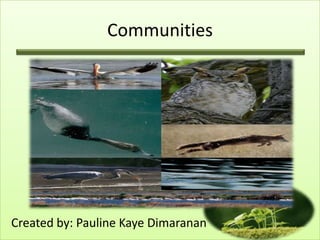
Pauline ppt
- 1. Communities Created by: Pauline Kaye Dimaranan
- 2. Tundra • Is a biome where the tree growth is hindered by low temperatures and short growing seasons. • The term tundra comes through Russian тундра word tūndâr "uplands", "treeless mountain tract“ • Some common animals in tundra are Polar Fox, White Fox
- 3. Three types of Tundra • Arctic Tundra • Arctic tundra occurs in the far Northern Hemisphere, north of the taiga belt. • Arctic tundra contains areas of stark landscape and is frozen for much of the year. • he soil there is frozen from 25–90 cm (10–35 in) down, and it is impossible for trees to grow
- 4. • Antarctic Tundra • Antarctic tundra occurs on Antarctica and on several Antarctic and subantarctic islands, including South Georgia and the South Sandwich Islands and the Kerguelen Islands. • Most of Antarctica is too cold and dry to support vegetation, and most of the continent is covered by ice fields.
- 5. • Alpine Tundra • Alpine tundra does not contain trees because the climate and soils at high altitude block tree growth. • Alpine tundra is distinguished from arctic tundra in that alpine tundra typically does not have permafrost, and alpine soils are generally better drained than arctic soils.
- 6. Taiga • also known as the boreal forest, is a biome characterized by coniferous forests consisting mostly of pines, spruces and larches. • Taiga is the world's largest land biome, and makes up 29% of the world's forest cover; the largest areas are located in Russia and Canada. • The taiga is the terrestrial biome with the lowest annual average temperatures after the tundra and permanent ice caps. • Common animals in taiga includes: Siberian Thrush , White's Thrush , Dark- throated Thrush , Golden Eagle, Bald Eagle , Long-earred Owl, Moose, Lynx, Beaver, Black bear, Bob cat, Red Fox, River otter, Gray wolf,
- 7. grassland • Grassland biomes are large, rolling terrains of grasses, flowers and herbs. Latitude, soil and local climates for the most part determine what kinds of plants grow in a particular grassland. • A grassland is a region where the average annual rain is great enough to support grasses, and in some areas a few trees. • Some common animals in the grasslands are Coyotes, Eagles, Bobcats, the Gray Wolf, Wild Turkey, Fly Catcher, Canadian Geese, Crickets, Dung Beetle, Bison, and Prairie Chicken.
- 8. Temperate Forest • temperate forests are areas with high levels of precipitation, humidity and contain a variety of deciduous trees. Deciduous trees lose their leaves in winter. • Temperate forests have a wide range of temperatures that correlate with the distinctive seasons. • Due to abundant rainfall and thick soil humus, temperate forests are able to support a wide variety of plant life and vegetation. • Common animals in temperate forest are various insects and spiders, wolves, foxes, bears, coyotes, bobcats, mountain lions, eagles, rabbits, deer, skunks, squirrels, raccoons, squirrels, moose and hummingbirds.
- 9. Tropical forest • Tropical rainforests can be characterized in two words: warm and wet. • This ecosystem experiences high average temperatures and a significant amount of rainfall. • Tropical rainforests are unique in the high levels of biodiversity they exhibit. • Tropical rainforests have been called the "jewels of the Earth" and the "world's largest pharmacy", because over one quarter of natural medicines have been discovered within them. • Common animals in tropical forest are: Anaconda, Jaguar, Toucan, Frog, Emergent, Canopy, Birds, Insect, etc
- 10. Desert • A desert is a landscape or region that receives an extremely low amount of precipitation, less than enough to support growth of most plants. • Deserts are sometimes classified as "hot" and "cold" deserts • Deserts take up about one third (33%) of the Earth's land surface.
- 11. Marine • It refers exclusively to saltwater environments • Marine regions cover about three-fourths of the Earth's • When it comes to the marine biome, climate doesn't really effect it much. It is warmer as you get closer to the equator and it is colder as you get closer to the poles. • When you think of the marine biome, health issues don't usually come to mind, but there are many problems facing the fish and animals of our ocean. Oil spills are a major issue • Common animals in marine are: whales, dolphins, sharks, walrus, star fish, eel, crabs, jelly fish, and fresh and salt water fish
- 12. Fresh water • is naturally occurring water on the Earth's surface in ice sheets, ice caps, glaciers, bogs, ponds, lakes, rivers and streams, and underground as groundwater in aquifers and underground streams. • is generally characterized by having low concentrations of dissolved salts and other total dissolved solids. • is a location where there is plenty of nutrition and minerals. That is why so many types of plants and animals are able to thrive in such a location. • Common animals in fresh water are: Manatees, frogs, raccoon, mosquitoes, salmon, amphibians, otters, turtles.
- 13. Evaluation • Context: what is the purpose of the presentation & intended audience? • Readability: Could you read the slides? • Format: titles/text/images clearly express the message? • Text: Too much, too little, perfect? • Design: did the slide design enhance the presentation? • Color: Did the colors make the presentation easier or more difficult to view? • Images: Were the pictures clear? • Transition: Were the slide transitions distracting or flowing? • Speed: Were the slide transitions too fast or too slow? • Overall: Did the PPT enhance the presentation? • Suggestions: for the presenter?
